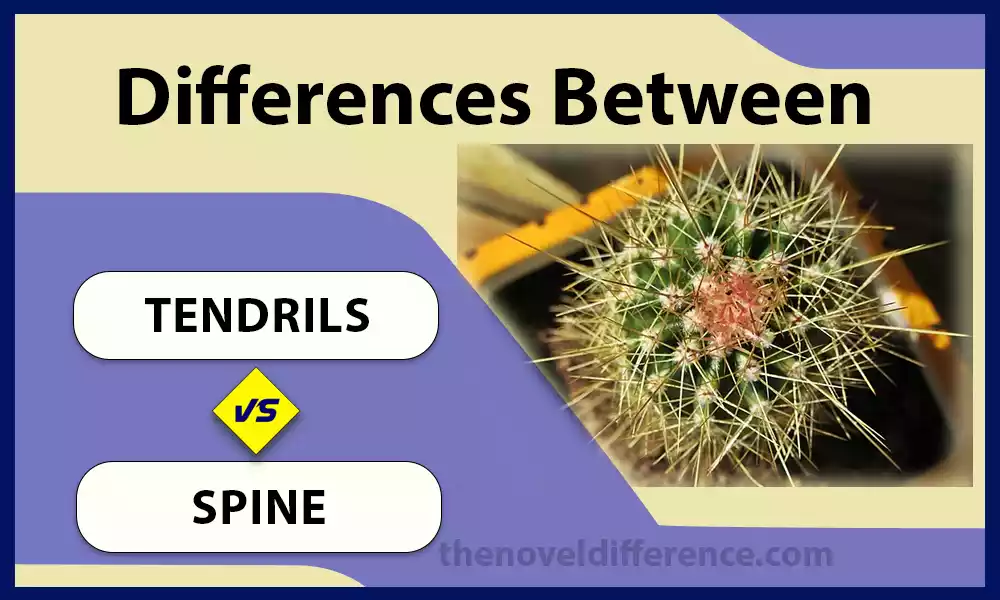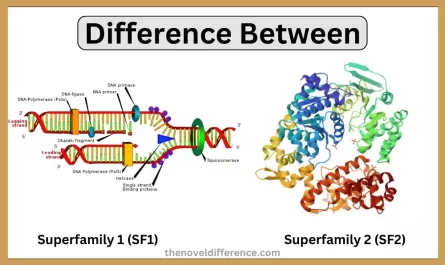Nature never ceases to amaze us with her diverse beauty. Among the fascinating elements found in the botanical world are tendrils and spines. These features serve various functions and can be seen across many species; each having its own set of special traits and functions. We will discuss spines and tendrils more thoroughly by exploring their distinct characteristics and functions in greater depth. So, let’s delve into the intriguing world of these botanical wonders.
Definition of Tendrils and Spine
Definition of Tendrils: Tendrils are thin, elongated, and specialized structures found in certain plants. They are typically slender and flexible, often resembling spirals, coils, or hooks. Tendrils are used by plants for climbing, attaching to support structures, and anchoring themselves. They are sensitive to touch and exhibit a twining behavior, allowing the plant to reach out and grasp onto nearby objects for support.
Definition of Spines: Spines are sharp, pointed structures found in various plants. They are typically rigid and can be found on leaves, stems, or as thorn-like projections. Spines serve a protective function, deterring animals from approaching or damaging the plant. These structures often resemble modified leaves or stems or stipules from different plant species and can range in shape, size, and hardness depending on what species of plant is growing the most prevalently in its ecosystem. Spines can provide defense against herbivores and help reduce water loss by reducing the surface area of the plant exposed to the environment.
Importance of understanding the difference between tendrils and spines
Understanding the difference between tendrils and spines is important for several reasons:
1. Plant Identification: Recognizing the presence of tendrils or spines can be useful in identifying plant species. Tendrils are commonly found in climbing plants, such as vines, whereas spines are characteristic of certain desert plants or plants with defensive adaptations. Understanding these features can aid in correctly identifying and classifying plants.
2. Gardening and Plant Care: Differentiating between tendrils and spines is essential for proper plant care. Plants with tendrils may require support structures or trellises for optimal growth and development. On the other hand, plants with spines may need specific handling techniques to avoid injury. Understanding these distinctions allows gardeners to provide the appropriate support and care for different types of plants.
3. Ecological Interactions: Tendrils and spines play important roles in plant interactions with the environment and other organisms. Tendrils enable climbing plants to access sunlight and grow toward support structures. They can also facilitate pollination by guiding insects toward flowers. As defenses against herbivores by keeping them from devouring plant tissues. Understanding these adaptations helps in comprehending the ecological dynamics and interactions within plant communities.
4. Conservation and Restoration Efforts: Knowledge of tendrils and spines is relevant to conservation and restoration projects. Identifying plants with specific adaptations, such as tendrils or spines, can provide insights into their ecological requirements and their roles within a particular ecosystem. This information is valuable when designing restoration plans, managing invasive species, and conserving biodiversity.
5. Scientific Research: Understanding the differences between tendrils and spines contributes to scientific research in various fields, including plant physiology, ecology, and evolutionary biology. Researchers can investigate the mechanisms behind tendril coiling and attachment, the genetic basis of spine development, or the ecological implications of these structures. Such research enhances our understanding of plant biology and informs broader scientific knowledge.
Understanding the distinction between tendrils and spines is crucial for plant identification, gardening practices, ecological studies, conservation efforts, and scientific research. It allows for accurate plant classification, appropriate plant care, and insights into plant-environment interactions.
What are Tendrils?
Tendrils are specialized structures found in certain plants that serve the purpose of climbing, support, and attachment. They are typically thin, elongated, and flexible, often exhibiting a spiraling or coiling shape. Tendrils can be observed in various plant families, including vines, cucurbits (such as pumpkins and cucumbers), and some legumes.
The main function of tendrils is to enable plants to climb or secure themselves to surrounding objects, such as trellises, fences, or other plants. By twining or curling around a support structure, tendrils allow the plant to reach upward, accessing more sunlight and optimizing its growth potential.
Tendrils are typically sensitive to touch and exhibit remarkable responsiveness known as thigmotropism. Once a tendril makes contact with something it will enclose it and expand around it giving your plant strength and support. This coiling mechanism is often driven by differential cell growth in the tendril, which causes it to twist and wrap around the support.
Tendrils can have different structures and variations depending on the plant species. Some plants have leaf tendrils, where the modified leaf structures function as tendrils. Other plants develop stem tendrils, which arise from modified stems or axillary buds. Some tendrils may also possess specialized adhesive pads or hooks to enhance their attachment to supports.

Tendrils are fascinating adaptations that enable certain plants to climb and secure themselves, improving their access to light and maximizing their chances of successful growth and reproduction.
Types of tendrils
There are several types of tendrils found in plants. The specific type of tendril a plant possesses can vary depending on the species and family.
Here are some common types of tendrils:
1. Leaf Tendrils: Leaf tendrils, as the name suggests, are modified leaf structures that have evolved to serve as tendrils. These tendrils arise from the leaf petiole or leaflet, and their form and shape can vary. Examples of plants with leaf tendrils include peas (Pisum sativum) and sweet peas (Lathyrus odoratus).
2. Stem Tendrils: Stem tendrils are derived from modified stems or axillary buds. These tendrils often grow opposite to leaves or leaflets and can be slender, coiling structures. Grapevines (Vitis spp.) are a well-known example of plants with stem tendrils.
3. Tendril Pads: Some plants have tendrils that end in specialized adhesive pads or discs. These pads help the tendrils to grip and adhere to surfaces, providing strong support for the climbing plant. Boston ivy (Parthenocissus tricuspidata) and Virginia creeper (Parthenocissus quinquefolia) are examples of plants with tendril pads.
4. Curling Tendrils: Curling tendrils are capable of wrapping around supports by coiling or spiraling. The Cucurbitaceae Plant Family Includes Cucumbers (Cucumis Sativus) and Squashes (Cucurbita Spp).
5. Clinging Tendrils: Clinging tendrils are specialized structures that enable plants to adhere to surfaces through a process called adhesion. These tendrils can secrete adhesive substances or produce suction cups that help the plant attach itself firmly to vertical or horizontal surfaces. Ivy (Hedera spp.) and Virginia Creeper (Parthenocissus quinquefolia) are examples of plants with clinging tendrils.
It’s important to note that not all plants possess tendrils. Tendrils are a specific adaptation found in certain plant species that rely on climbing and support structures to thrive.
Leaf tendrils
Leaf tendrils, as the name suggests, are specialized structures that originate from modified leaves and serve the purpose of climbing and attachment. These tendrils are typically slender, elongated, and possess a coiling or spiraling shape.
They are found in certain plant species as an adaptation for securing the plant to support structures. Leaf tendrils can vary in appearance and structure depending on the plant species.
Here are a few examples of plants with leaf tendrils:
1. Peas (Pisum sativum): Peas are well-known legume plants that have leaf tendrils. The tendrils arise from the petiole of the leaf and coil around nearby objects for support. This enables the pea plant to climb and reach for sunlight.
2. Sweet Peas (Lathyrus odoratus): Sweet peas are flowering plants that also possess leaf tendrils. The tendrils emerge from the leaf nodes and exhibit a delicate and curling structure. Sweet peas use these tendrils to twine around structures such as trellises or other plants.
3. Grapevines (Vitis spp.): Grapevines are woody climbing plants that utilize leaf tendrils for support and climbing. The tendrils are modified leaf structures that develop opposite the leaves. They coil around wires, trellises, or other plants, assisting the grapevine in ascending and spreading.
Leaf tendrils are typically sensitive to touch and respond to contact with an object by coiling around it. This coiling behavior helps the plant secure itself to the support structure and provides stability as it grows vertically.
Leaf tendrils are fascinating adaptations that enable plants to utilize their leaves for climbing and attachment, allowing them to access more light and space in their environment.
Stem tendrils
Stem tendrils are specialized structures that originate from modified stems or axillary buds in certain plant species. These tendrils serve the purpose of climbing, attaching, and providing support to the plant. Stem tendrils are slender, elongated structures that often exhibit a coiling or twisting shape.
Here are some examples of plants that possess stem tendrils:
1. Grapevines (Vitis spp.): Grapevines are well-known plants that utilize stem tendrils for climbing and support. These tendrils emerge from the nodes along the vine’s stems and wrap around structures such as wires or trellises. The coiling action of the tendrils allows the grapevine to climb and reach sunlight for optimal growth.
2. Passionflowers (Passiflora spp.): Passionflowers are a diverse group of plants that often have intricate and beautiful flowers. Many passionflower species produce stem tendrils that aid in climbing and supporting the vine. The tendrils arise from the axillary buds and help the plant secure itself to nearby structures.
3. Clematis (Clematis spp.): Clematis is a genus of flowering plants that includes various species with stem tendrils. These tendrils emerge from the axillary buds along the stems and assist the plants in climbing and attaching to structures like trellises or fences.
Stem tendrils, similar to leaf tendrils, are responsive to touch and exhibit thigmotropism. When tendrils come in contact with objects or structures, their tendrils wrap tightly around them to give the plant stability and support it needs for survival.
Stem tendrils are an adaptation that allows plants to efficiently utilize their stems for climbing and attachment, enabling them to reach higher levels and access more sunlight for photosynthesis and growth.
What are Spines?
Spines are sharp, pointed structures found in certain plants. They are typically rigid, modified plant organs that serve various functions, including protection, defense, and water conservation. Spines can be found on various parts of a plant such as its stems or leaves – in other cases, they form projections similar to thorns that act like spikes.
Here are some key characteristics and functions of spines:
1. Protection and Defense: Spines act as a defense mechanism, deterring animals from approaching or damaging the plant. Plant barriers present physical obstructions which make it hard for herbivores to gain access to plant tissue and gain entry. Spines can be sharp, prickly, or barbed, making them an effective deterrent against potential predators.
2. Reduced Surface Area: Spines often contribute to reducing the surface area of the plant exposed to the environment. By minimizing the leaf surface, plants with spines can reduce water loss through transpiration, thus helping to conserve water in arid or desert environments.
3. Modified Leaf or Stem Structures: Spines are typically modified plant organs. In some cases, they are modified leaves, known as leaf spines, where the leaf blade has transformed into a pointed structure. In other instances, spines can be modified stems, known as stem spines, arising from the stem’s surface or axillary buds.
4. Diversity of Forms: Spines come in various sizes, shapes, and textures. They can be long, slender, needle-like structures or larger, robust thorns. Some spines have hooked or barbed ends, enhancing their effectiveness in preventing animal grazing or physical contact.
5. Plant Adaptations: Spines are often associated with plants living in challenging environments, such as deserts or arid regions. They help these plants cope with harsh conditions by reducing water loss, protecting against herbivory, and providing structural support.
Substances that exhibit spines include succulents (Cactaceae family) as well as Agave plants, Acacias (Acacia Genus), and various succulent species.

Spines Play an Essential Part in Ensuring the Survival and Adaptability of Plants, Providing Protection From Herbivores as Well as Decreasing Water Loss. Understanding spines help us appreciate the diverse strategies plants employ to thrive in different ecological niches.
Types of spines
There are various species of spines on plants, each boasting its own set of distinctive characteristics. The specific types of spines a plant possesses can vary depending on the species and plant family.
Here are some common types of spines:
1. Leaf Spines: Leaf spines are sharp, pointed structures that arise from modified leaf tissues. They can be found along the leaf margins or as extensions of the leaf surface. Leaf spines can be long, needle-like structures or shorter, stout thorns. Examples of plants with leaf spines include holly (Ilex spp.) and some species of roses (Rosa spp.).
2. Stem Spines: Stem’s spines are modified structures that arise from the stem’s surface or axillary buds. They can be long, robust, and rigid or short and stubby. Stem spines protect the plant and can be found on the main stems or branches. Cacti and some species of Acacias (Acacia spp.) are two plants with spined stems which are commonly seen.
3. Thorn-like Structures: Some plants possess thorn-like structures that are not true spines but still serve similar functions. Thorns differ from spines in that they are modified branches or parts of the stem rather than modified leaves. Thorns can be sharp, pointed, and woody, providing protection and defense. Hawthorn (Crataegus spp.) and blackthorn (Prunus spinosa) are examples of plants with thorny structures.
4. Prickles: Prickles are sharp, pointed outgrowths found on the surface of stems or other plant parts. Unlike spines, prickles can be easily detached from the plant and are not true modifications of the plant’s tissues. Prickles Can Be Found in Flowers Such as Roses (Rosa spp.) and Blackberries (Rubus spp.).
Keep in mind that different words used to refer to plant parts may vary and cause confusion or overlap among terms like spines, thorns,0, or prickles. Understanding the general characteristics and functions of these protective structures helps in recognizing and appreciating the diverse adaptations plants have evolved to survive and thrive in their respective environments.
Leaf spines
Leaf spines are sharp, pointed structures that arise from modified leaf tissues in certain plant species. They serve a defensive function, deterring herbivores from approaching or damaging the plant. Leaf spines are typically rigid and can be found along the margins or as extensions of the leaf surface.
Here are some key features and examples of plants with leaf spines:
1. Structure: Leaf spines can vary in size, shape, and texture. They can be long and needle-like or short and stout. Leaf spines are often stiff and pointed, providing an effective physical barrier against herbivores.
2. Leaf Margin Spines: Some plants have spines along the leaf margins. These Spines May Be Small or Large Depending on the Species of Animal They Belong To. They act as a deterrent, preventing animals from grazing on the leaf edges and protecting the plant’s tissues. Holly (Ilex spp.) is an example of a plant with leaf margin spines.
3. Surface Spines: Certain plant species have spines that arise from the leaf surface itself. These spines may be scattered across the leaf or concentrated in specific areas. Rose bushes (Rosa spp.) are well-known examples of plants with surface spines on their leaves. The spines on rose leaves are modified structures that protect against herbivory.
4. Function: Leaf spines serve as a defense mechanism, deterring herbivores and reducing the likelihood of leaf damage. They make it more challenging for animals to consume the plant’s tissues and can deter browsing animals from approaching altogether.
Leaf spines are typically found in plants that inhabit environments with grazing pressure or other herbivore threats. By evolving spines, these plants have developed an effective means of defense against herbivory, enhancing their chances of survival and reproduction.
Keep in mind that, although leaf spines are distinct plant structures, other plant parts like prickles or thorns could easily be mistaken as leaf spines due to their similar appearance. Leaf spines specifically refer to modified leaf tissues that provide protection and defense.
Stem’s spines
Stem spines are sharp, pointed structures that arise from modified stem tissues or axillary buds in certain plant species. These spines serve various functions, including defense, protection, and deterrence against herbivores. Stem spines can be found along the main stem or branches of a plant.
Here are some key features and examples of plants with stem spines:
1. Structure: Stem spines can vary in size, shape, and texture. They can be long and rigid or shorter and more stubby, depending on the species. Stem spines are often sharp, pointed, and rigid, making them effective deterrents against herbivores.
2. Protection: Stem spines act as a defensive adaptation, discouraging animals from approaching or damaging the plant. Herbivorous creatures cannot access plant tissues as easily, thus decreasing grazing or browsing risks.
3. Distribution: Stem spines can be distributed along the length of the main stem, branches, or axillary buds. They can be evenly spaced or concentrated in certain areas, depending on the plant species. Cacti (Cactaceae family) are well-known examples of plants with stem spines that cover their entire surface, protecting herbivory and excessive water loss.
4. Function: Stem spines serve as a deterrent against herbivory, protecting the plant from grazing animals. The presence of spines on stems makes it less likely for animals to come into contact with the plant or attempt to consume its tissues.
Cacti that have spines on their stems include the Saguaro Cactus (Carnegiea gigantea) and Prickly Pear Cacti (Opuntia spp). These plants have evolved stem spines as adaptations to survive in arid environments, providing defense against herbivores and reducing water loss through transpiration.
Stem spines, along with other defensive structures like leaf spines and thorns, are important adaptations that help plants thrive and protect themselves in their respective habitats.
Comparison Chart
Here’s a comparison chart highlighting the main differences between tendrils and spines:
| Features | Tendrils | Spines |
|---|---|---|
| Function | Aid in climbing and attachment | Defense and protection |
| Location | Can arise from leaves, stems, or buds | Can be found on leaves, stems, or branches |
| Adaptation | Facilitate plant growth and access to resources | Deter herbivores and prevent damage |
| Structure | Flexible, slender, coiling, or twining | Rigid, sharp, pointed |
| Sensitivity | Sensitive to touch and respond by coiling | Not typically sensitive to touch |
| Ecological Role | Access sunlight and gain a competitive advantage | Deter herbivores and reduce damage |
Conclusion
The differences between tendrils and spines lie in their form, function, and purpose within the plant kingdom. Tendrils, with their delicate coils, facilitate climbing and support, while spines act as nature’s armor, protecting plants from potential threats. Understanding these distinctions deepens our appreciation of the plant world, giving us insight into its intricate patterns. When encountering plants with spines or tendrils, look around and be amazed at their power of adaptation and survival!




